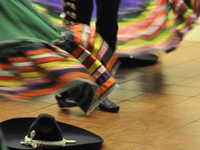
Mariachi Véritas de Harvard holds a concert at the Student Organization Center at Hilles (SOCH) with guest performers from Brown, Dartmouth, and the San Marcos (Texas) Mariachi Academy on Saturday
Last Friday and Saturday, Mariachi Véritas de Harvard did not simply draw audience members to listen to their music, but inspired them to join in. Students cheered and sang along to classic mariachi songs—such as José Alfredo Jiménez’s “El Rey”—in a weekend of festivity. Though common in Southwestern states like Texas and California, the Mariachi genre has a much smaller presence in New England. Nonetheless, Mariachi Véritas managed to fill the cinema at the Student Organization Center at Hilles (SOCH) with the spirited sounds of mariachi music, and performed with several prestigious East Coast collegiate ensembles and a high school ensemble from San Marcos, Texas. Founded 10 years ago, Mariachi Véritas has not only grown in reputation and authenticity, but is also taking ambitious strides to increase the prevalence of mariachi music in a place far from its Southwestern roots.
Though Mariachi music is alive and well at Harvard today, members of Mariachi Véritas can recall the ensemble’s humble beginnings. “When we started out, the musicians would wear black pants and polo shirts to a gig. We now have full, traditional mariachi suits,” said Mariachi Véritas president Karl U. Wichorek ’11. Mariachi Véritas vice president Diego Rentería ’11-’12 also notes another distinctive change. “When I started, the Mariachi group here did not memorize their music and played with music stands,” said Rentería. “In reality, in Mariachi performance you have to have your music memorized and [perform while] standing. That tradition has been passed down [so that you] perform [without] anything between you and the audience.” It is these significant gains in authenticity that has contributed to the ensemble’s success.
Mariachi Véritas have performed many times in the past, but have never collaborated as extensively with other ensembles as they did this weekend. One of these groups is Berklee College of Music’s “Mariachi de Berklee.” “[With] Berklee’s mariachi coming in [last Friday] ... the two finest student mariachis on the East coast are performing in one concert, which is really something. Mariachi is definitely something that is very much centered in the Southwestern United States. The fact that we are becoming a hub for this sort of activity in the Northeast, I think adds a new dimension to our concert,” said the ensemble’s music director George W. Zuo ’13. In addition, Mariachi Véritas also performed alongside San Marcos Mariachi Academy’s “Mariachi Bondad” and Brown University’s “Mariachi de Brown,” illuminating the national scope of Mariachi Véritas’ artistic collaboration.
Mariachi Bondad, a high school ensemble from Texas, holds special significance for Mariachi Véritas. “When the group was founded, the goal was to share Mariachi music with the Harvard community and the wider-Boston community—and we’ve definitely done that. But another goal of the group is to act as role models for youth. In that sense, I think it is a great opportunity for [Mariachi Bondad] to see Mariachi music and the cultural heritage outside [of] an area like California and Texas and see it flourish in an area as far as the Northeast,” said Wichorek. However, inviting Mariachi Bondad was not only rewarding for its high school musicians, but also for the Harvard community. “They show [to the Harvard community] that ... there are areas where marching bands and jazz ensembles are ingrained in the high school culture, [but there are also] areas where Mariachi music and other sorts of Mexican or Latino music are a really big part of it—so much that there is an academy and extracurricular high school and cultural groups designed to teach it and promote it,” said Rentería.
Just as it has worked to progress from its humble beginnings, Mariachi Véritas made the most of their humble performance space at SOCH during their concerts on Friday and Saturday. By the end of Saturday night, the hall was alive with cheering and singing, and the concert felt a world away from Harvard’s New England campus. Saturday’s concert was complemented by appearances from ballet folklórico groups from both Harvard College and Dartmouth College with the evening of artistic collaboration exemplified in the final number, “La Negra,” performed by all the ensembles—both mariachi and ballet.
Mariachi Bondad’s performance endeared all with their passion and their impressive technique while Mariachi de Brown, the smallest ensemble of the evening, proved to be the most exuberant of them all. One of their guitarists practically leapt off the ground with excitement and their lead vocalist, Daniel Villalobos, earned a standing ovation with his rich tenor. Mariachi Véritas displayed classical perfection and an earnest love for the music, their musicians shining particularly in “Tu Nombre Me Sabe a Yerba.”
The mariachi art form, unlike many others, is fueled not only by the passion of its musicians but also the audience’s response. “When we play music and we see everyone in the crowd singing along with us, they are all bonding over these songs that everybody knows and they are laughing and yelling and screaming,” said Zuo. “You will never get that in an orchestra. You will never get that in the very traditional modes of expressing music.”
Read more in Arts
Exhibit Captures Spring’s Vibrant Energy













